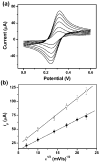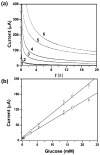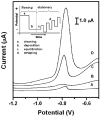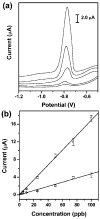Electrochemical sensing in paper-based microfluidic devices
- PMID: 20126688
- PMCID: PMC3065124
- DOI: 10.1039/b917150a
Electrochemical sensing in paper-based microfluidic devices
Abstract
This paper describes the fabrication and the performance of microfluidic paper-based electrochemical sensing devices (we call the microfluidic paper-based electrochemical devices, microPEDs). The microPEDs comprise paper-based microfluidic channels patterned by photolithography or wax printing, and electrodes screen-printed from conducting inks (e.g., carbon or Ag/AgCl). We demonstrated that the microPEDs are capable of quantifying the concentrations of various analytes (e.g., heavy-metal ions and glucose) in aqueous solutions. This low-cost analytical device should be useful for applications in public health, environmental monitoring, and the developing world.
Figures





Similar articles
-
A novel screen-printed microfluidic paper-based electrochemical device for detection of glucose and uric acid in urine.Biomed Microdevices. 2016 Oct;18(5):92. doi: 10.1007/s10544-016-0115-6. Biomed Microdevices. 2016. PMID: 27628060
-
Electrochemical detection for paper-based microfluidics.Anal Chem. 2009 Jul 15;81(14):5821-6. doi: 10.1021/ac9007573. Anal Chem. 2009. PMID: 19485415
-
Glucose biosensor based on disposable electrochemical paper-based transducers fully fabricated by screen-printing.Biosens Bioelectron. 2018 Jun 30;109:8-12. doi: 10.1016/j.bios.2018.02.061. Epub 2018 Feb 28. Biosens Bioelectron. 2018. PMID: 29522970
-
Detection of heavy metal by paper-based microfluidics.Biosens Bioelectron. 2016 Sep 15;83:256-66. doi: 10.1016/j.bios.2016.04.061. Epub 2016 Apr 21. Biosens Bioelectron. 2016. PMID: 27131999 Review.
-
Recent advances in microfluidic paper-based electrochemiluminescence analytical devices for point-of-care testing applications.Biosens Bioelectron. 2019 Feb 1;126:68-81. doi: 10.1016/j.bios.2018.10.038. Epub 2018 Oct 22. Biosens Bioelectron. 2019. PMID: 30391911 Review.
Cited by
-
Consumer-Grade Inkjet Printer for Versatile and Precise Chemical Deposition.ACS Omega. 2021 Mar 9;6(11):7786-7794. doi: 10.1021/acsomega.1c00282. eCollection 2021 Mar 23. ACS Omega. 2021. PMID: 33778290 Free PMC article.
-
Electrical Characterization of Cellulose-Based Membranes towards Pathogen Detection in Water.Biosensors (Basel). 2021 Feb 21;11(2):57. doi: 10.3390/bios11020057. Biosensors (Basel). 2021. PMID: 33670061 Free PMC article.
-
Lab-on-a-Chip Platforms for Airborne Particulate Matter Applications: A Review of Current Perspectives.Biosensors (Basel). 2022 Mar 24;12(4):191. doi: 10.3390/bios12040191. Biosensors (Basel). 2022. PMID: 35448251 Free PMC article. Review.
-
Paper based microfluidic devices: a review of fabrication techniques and applications.Eur Phys J Spec Top. 2023;232(6):781-815. doi: 10.1140/epjs/s11734-022-00727-y. Epub 2022 Dec 12. Eur Phys J Spec Top. 2023. PMID: 36532608 Free PMC article. Review.
-
Paper-Based Sensors: Emerging Themes and Applications.Sensors (Basel). 2018 Aug 28;18(9):2838. doi: 10.3390/s18092838. Sensors (Basel). 2018. PMID: 30154323 Free PMC article. Review.
References
-
- Dungchai W, Chailapakul O, Henry CS. Anal Chem. 2009;81:5821–5826. - PubMed
-
- Hones J, Muller P, Surridge N. Diabetes Technol Ther. 2008;10:S10–S26.
-
- World Health Organization. Guidelines for Drinking-Water Quality. WHO, WHO Press; Switzerland: 2006.
Publication types
MeSH terms
Substances
Grants and funding
LinkOut - more resources
Full Text Sources
Other Literature Sources
Miscellaneous

